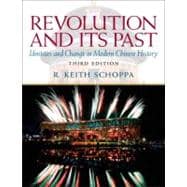
Note: Supplemental materials are not guaranteed with Rental or Used book purchases.
Purchase Benefits
Preface
Notes on Pronunciation
List of Maps
Part 1: From the Heights to the Depths: Challenges to Traditional Chinese Identities, 1780—1901
Chapter 1: IDENTITIES
History and Identity
Associational Identities: Lineages and Families
Associational Identities: Social Connections
Associational Identities: Relations to the “Other”
Spatial Identities: Native Place
Spatial Identities: Village and Marketing Communities
Spatial Identities: Macroregions and Provinces
Chapter 2: CHINESE AND MANCHUS
Patterns in Early Qing
Preserving a Manchu Identity
Buying Into Chinese Culture
Dealing with the Other
Identity and Change: The Qianlong Emperor in the Late Eighteenth Century
Identity Crisis
Emerging Problems
The Daoguang Emperor
Chapter 3: THE OPIUM WAR AND THE TREATY SYSTEM: CHALLENGES TO CHINESE IDENTITY
The Early Western Role
China and the West: Mutual Perceptions
Opium: The Problem and the War
The Unequal Treaty System and Its Impact on Chinese Identity
The Missionary and Cultural Imperialism
Chapter 4: AN AGE OF REBELLION: DEFIANCE OF AND COMMITMENTS TO TRADITIONAL CHINESE IDENTITIES
Traditional Rebellions
The Taiping War (1851—1864): Attempting to Revolutionize Identity
Guerrilla Warfare: The Nian Rebellion (1853—1868)
Muslims versus Chinese: Clashes in Ethnic Identity
Chapter 5: THE POWER OF TRADITIONAL CULTURAL IDENTITY: CHINESE REACTIONS TO CONTINUING THREATS
Unwilling to Change (Or Holding to that Old-Time Identity)
Self-Strengthening
The Loss of Tributary States: Ryukyu Islands, Korea, and Vietnam
The War with France and the Impact of Self-Strengthening
Identity and Perception: The Roles of the Empress Dowager
Chapter 6: THE DEVASTATING NINETIES: DESTROYING TRADITIONAL IDENTITIES
Ideology for Change: Kang Youwei’s Intellectual Bomb
Political and Cultural Earthquake: Defeat by the “Dwarf People”
A New Phase of Imperialism: Carving the Melon
The Reform Movement and the Hundred Days: Clashing Identities
The Boxer Catastrophe: Which Identity Now?
Part 2: “No Checking the Tides of Change”: Reconstructing Social, Cultural, and Political Identity, 1901—1928
Chapter 7: Revolutionaries: Manchu and Anti-Manchu
The Stirrings of a New China in Macroregional Cores
The Manchu Reform Movement: Education
The Manchu Reform Movement: Military Change
The Manchu Reform Movement: Constitutionalism
The Anti-Manchu Revolutionary Movement
The 1911 Revolution
Chapter 8: SELECTING IDENTITIES: THE EARLY REPUBLIC
Legacies of the Revolution
The Presidency of Yuan Shikai
Capitalists to the Fore
The Power of the Gun
China Totters on the World Stage
Chapter 9: CONSTRUCTING A NEW CULTURAL IDENTITY: THE MAY FOURTH MOVEMENT
The New Culture Movement: “Down with Confucius and Sons”
Language and Laboratories for a New Culture
The May Fourth Incident and Its Aftermath
Political Change First; Cultural Change Will Follow
Cultural Change First; Political Change Will Follow
Neotraditionalism
The Historical Significance of the May Fourth Movement
Chapter 10: DRAWING THE SWORD OF OPPOSITION: IDENTITY INCREASINGLY POLITICIZED
The Birth of the Chinese Communist Party
Giving the Guomindang a New Identity
Things Fall Apart: Sun’s Death and the May 30th Movement
The Beginning of Mass Mobilization
The Emergence of Chiang Kai-shek and the Northern Expedition
Part 3: Revolution and Identity: Social Revolution and the Power of Tradition, 1928—1960
Chapter 11: REVOLUTION IN RETREAT: THE NANJING DECADE
Chiang Kai-shek
Military Power, Party Factionalism, and Residual Warlordism
Secrets of Chiang’s Ability to Retain Power
Chiang’s Record
Chapter 12: REVOLUTION REBORN: THE COMMUNISTS IN THE 1930s
The Party: “So Widely Scattered and So Badly Mauled”
Finding Its Way: The Party’s Factions
The Jiangxi Soviet
The Other Soviets
The Long March
Building the Base at Yan’an
Chapter 13: A RISING CLASH OF NATIONAL IDENTITIES: CHINA AND JAPAN, THE 1920s AND 1930s
A Case of Mistaken Identity
Japanese Aggression Turns Manchuria into Manchukuo
Japanese Aggression on the March
The Xi’an Incident
Marco Polo Bridge
Chapter 14: THE SINO—JAPANESE WAR, 1937—1945
The War’s General Course: An Overview
The Exodus
Soldiers and the Military
Collaboration
Wartime Propaganda
The United States and China in Wartime: Rough Sledding
The Communists in Yan’an, 1942—1945
Wartime Guomindang China
Chapter 15: TOWARD DAYBREAK: STRUGGLING FOR CHINA’S IDENTITY, 1945—1949
The Situation at War’s End
Economic Suicide
Political Disaster
Military Struggle
Did Chiang Lose the War or Did Mao Win the War?
Japan’s Colony, Taiwan
Guomindang Relations with the Taiwanese: February 1947 and Its Impact
Chapter 16: PATHS TO THE FUTURE
The Structure of the Communist Party-State
The East Is Red: The Hallmarks of the Communist Revolution
At War with the United Nations: The Korean War
The First Five-Year Plan (1953—1957)
The Taiwan Model: Authoritarianism and Reform
The Taiwan “Miracle”
Chapter 17: COMING UNGLUED
“Let a Hundred Flowers Bloom!” (Then Cut Them Down)
The Great Leap Forward (and Backward)
The Worst Famine in History
The Sino—Soviet Split
Crack-Up
Part 4: From “Politics in Command” to the Glory of Getting Rich: Contemporary Change and Identity, 1961—2009
Chapter 18: DEATH DANCE: THE GREAT PROLETARIAN CULTURAL REVOLUTION
Why?
The Violently Radical Red Guard Phase, 1966—1969
The Mystery of Lin Biao
The Year of the Dragon
Mao in Retrospect
Chapter 19: ECONOMICS IN COMMAND: THE END OF COMMUNISM AND THE FLOURISHING OF “MARKET SOCIALISM”
Socialism with a Chinese Face
Opening the Window to the World
The Expansion of Economic Reforms, 1990-2009
Government Action in Dealing with Impacts of Reform
Chapter 20: “ONE WORLD, ONE DREAM”: CHINA’S NEW WORLD
Political Authoritarianism
Nationalism and International Relations
2008: Achievements and Problems
Chapter 21: A QUESTION OF IDENTITY: THE REPUBLIC OF CHINA ON TAIWAN SINCE THE 1970s
Birth of a Democracy
The Issue: The Relationship with the PRC
From Economic Miracle to Economic Problems
Diplomacy: Seeking Respect
Society in Flux
A Question of Identity
Epilogue: The Issue of Human Rights
Notes
Pronunciation Guide
Index
Credits
The New copy of this book will include any supplemental materials advertised. Please check the title of the book to determine if it should include any access cards, study guides, lab manuals, CDs, etc.
The Used, Rental and eBook copies of this book are not guaranteed to include any supplemental materials. Typically, only the book itself is included. This is true even if the title states it includes any access cards, study guides, lab manuals, CDs, etc.